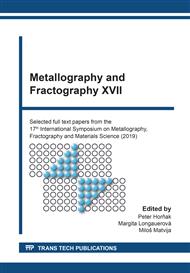p.92
p.100
p.109
p.115
p.121
p.127
p.133
p.139
p.145
Microstructure Influenced by Controlled Rolling, Cooling and Thermal Processing of Seamless Tubes Made of Steel 25CrMo4
Abstract:
By use of physical simulations, it was studied the influence of finish rolling temperature (from 820 °C to 970 °C) on the microstructural and mechanical properties of seamless tubes with a different wall thickness (from 6.3 to 40 mm) – in the state after rolling as well as after quenching and tempering. In laboratory conditions, by use of the Simulator HDS-20, the bloom piercing and rolling of the seamless tubes from 25CrMo4 low-alloy steel in a pilger mill were in a simplified way simulated. The wall thickness of the tube influenced the total deformation of specimens at anisothermal multi-pass plain-strain compression tests as well as the final cooling rate. The quenching and tempering of the deformed specimens was subsequently performed with use of the electric resistance furnaces. The finish rolling temperature had only insignificant effect on the resulting properties. Markedly lower hardness was obtained only after the simulation of tube production with the wall thickness of 40 mm contrary to the wall thickness of 6.3 and 20 mm. Structural variations of the specimens after rolling simulations were more or less overlapped by the subsequent quenching from the temperature of 850 °C and tempering at the temperature of 680 °C.
Info:
Periodical:
Pages:
121-126
Citation:
Online since:
November 2020
Price:
Сopyright:
© 2020 Trans Tech Publications Ltd. All Rights Reserved
Share:
Citation:


